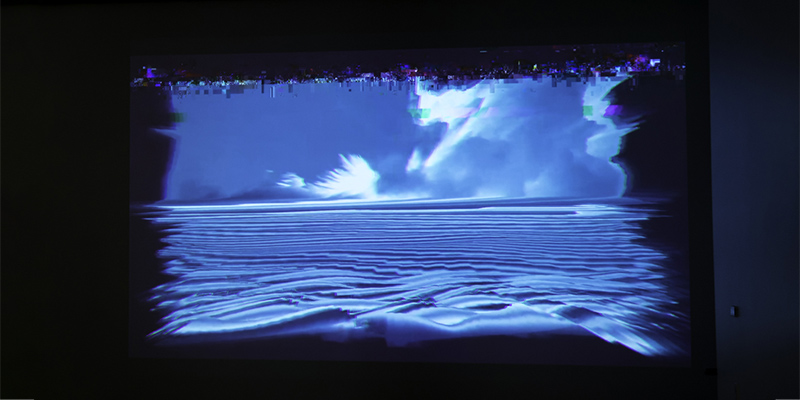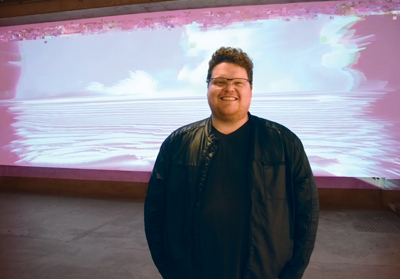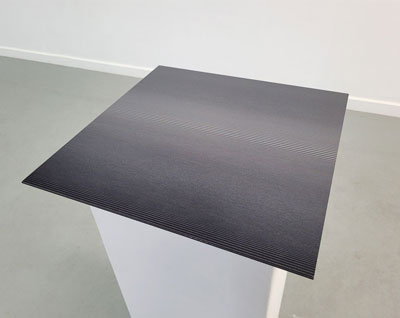From Foundation Studies to PhD and beyond
By Melissa Keogh
 CREATIVE INDUSTRIES Thomas Folber, Eidetic, 2021, stereo video projection, 3m37s cyclical loop, dimensions variable.
CREATIVE INDUSTRIES Thomas Folber, Eidetic, 2021, stereo video projection, 3m37s cyclical loop, dimensions variable.Visual artist Thomas Folber is proof that there is more than one pathway to success.
 Thomas Folber. Photo by Peri Strathearn.
Thomas Folber. Photo by Peri Strathearn.Thomas is UniSA’s first Foundation Studies graduate to have successfully worked their way up to a PhD, following a 13-year journey of visual arts study.
Upon handing in his PhD, Thomas also launched an exhibition Artefacts from the Black Box, including artworks from his research, at the South Australian School of Art (SASA) Gallery on UniSA’s City West campus.
“My PhD research focuses on understanding how post-digital ‘glitch’ aesthetics operate in relation to processes of remediation within a studio-based visual arts context,” he says.
“… my research primarily involves creating ‘glitchy’ digital artworks and translating them between formats and media to better understand how glitch aesthetics, and the processes used in their creation, operate.”
Thomas began his journey at UniSA in 2010 when he enrolled in the Foundation Studies program through what is now known as UniSA College.
 Thomas Folber, Magnetize, 2022, Ultra-violet ink on aluminium, 40x40cm.
Thomas Folber, Magnetize, 2022, Ultra-violet ink on aluminium, 40x40cm.He had been forced to drop out of high school because of illness, leaving him without an ATAR to seek entry to university.
The UniSA Foundation Studies program is designed for people who don’t meet entry requirements for their desired degree, including school leavers without an ATAR.
“Having an alternate pathway into tertiary study such as this was so valuable. I successfully completed this program part-time over two years,” Thomas says.
“Upon completing my bachelor degree, majoring in painting in 2014, I felt I was still just scratching the surface so decided to pursue an Honours.”
As well as pursuing Honours, Thomas also became a student mentor at UniSA College, supporting students with the transition to university and helping them develop their academic skills.
A year later in 2018 was time to take on his biggest challenge yet – a PhD.
“Having not completed high school, I was still feeling a bit of imposter syndrome regarding taking on a PhD,” Thomas says.
“I have to say that the UniSA staff, and my family and friends, were incredibly generous with their encouragement and support. Their genuine belief in my abilities inspired me to feel like I could take on the challenge, and my partner Maggie has been especially supportive.”
Thomas says that while pursuing a PhD was “an absolute marathon and all-consuming” – it is possible to manage both academic and family life.
“During my candidature, my partner and I had our first child in 2019, and our second in 2023 just as I was finishing my research,” he says.
“It has been a fantastic time to have kids. I was able to work from home most of the time and switching my PhD to part-time allowed me to be a really involved dad during such a special and fleeting time. It is certainly difficult sometimes but having kids can be a nice reminder to keep that work/life balance in check.”
Having a support network was key, as Thomas worked with primary supervisor Professor Simon Biggs as well as co-supervisors, artists and adjuncts Greg Donovan and Olga Sankey.
As for next steps, Thomas plans to take a few months off before seeing what the next chapter of life has in store.
“I love teaching at UniSA – helping other students pursue their academic interests is such a privilege,” he says.
“I am also looking forward to continuing to develop my creative research and pursue artistic opportunities interstate and internationally, if possible.”
Thomas’s exhibition, Artefacts from the Black Box, is showing at the SASA Gallery, UniSA City West campus, until 23 June. Open Thursdays and Fridays, 10am – 5pm.
Other Stories
- Australian teachers at breaking point as budget delivers superficial support
- Substandard rental housing a threat to resident health and wellbeing
- Why you should learn the Kaurna phrase Yangadlitya Kumangka
- The WHO says we shouldn’t bother with artificial sweeteners for weight loss or health. Is sugar better?
- From the Vice Chancellor: Universities Accord – What’s the big idea here?
- Achievements and Announcements
- Mother and son pair celebrate graduation from Aboriginal Pathway Program
- From Foundation Studies to PhD and beyond
- Accolades for two influential Aboriginal voices as UniSA endorses wider principle
- In Pictures: MOD. holds its biggest party yet + National Reconciliation Week
- The latest books from UniSA researchers




